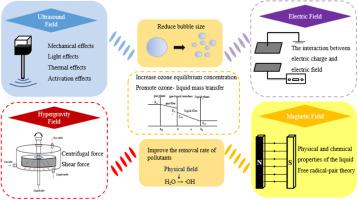Journal of Environmental Chemical Engineering ( IF 7.4 ) Pub Date : 2021-07-26 , DOI: 10.1016/j.jece.2021.106115 Bing Wang 1, 2 , Wen Shi 1 , Huan Zhang 1 , Hongyang Ren 1 , Mingyang Xiong 1

|
Ozonation process is a crucial advanced oxidation process and has been commonly used for the degradation and mineralization of refractory pollutants. Ozonation water treatment process needs to transfer ozone from gas to the water phase. Although the solubility of ozone in water is higher than that of oxygen in water under the same conditions, it still belongs to the type of liquid film control in mass transfer. In the research of ozone oxidation process technology, enhancing the ozone-liquid mass transfer can improve ozone utilization efficiency and its technical economy. Therefore, numerous ozone-based process intensifications have been explored. This paper provided a summary of the application of external physical fields (ultrasonic field, hypergravity field, electric field, and magnetic/electromagnetic field) to strengthen ozone-liquid mass transfer and briefly explains the recent literature, which has applied the combination of external physical fields and ozonation to destroy organic compounds. The results show that ultrasonic can increase the mass transfer coefficient of ozone by 20–200% under optimized conditions and ultrasound can generate free radicals through its cavitation. The hypergravity field can increase the mass transfer coefficient by at least 1.5 times. The addition of electric and magnetic fields also increases the mass transfer of ozone by more than 40% or more under optimized conditions.
中文翻译:

通过外部物理场促进臭氧-液体传质及其在废水处理中的应用:综述
臭氧化工艺是一种重要的高级氧化工艺,常用于难降解污染物的降解和矿化。臭氧水处理过程需要将臭氧从气态转移到水相。臭氧在水中的溶解度虽然在同等条件下比氧气在水中的溶解度高,但在传质中仍属于液膜控制的类型。在臭氧氧化工艺技术研究中,加强臭氧-液体传质可以提高臭氧利用效率和技术经济性。因此,已经探索了许多基于臭氧的过程强化。本文对外部物理场(超声波场、超重力场、电场、和磁场/电磁场)以加强臭氧-液体传质并简要解释最近的文献,这些文献已应用外部物理场和臭氧化的组合来破坏有机化合物。结果表明,超声在优化条件下可使臭氧的传质系数提高20%~200%,超声可通过空化作用产生自由基。超重力场可将传质系数提高至少 1.5 倍。在优化条件下,电场和磁场的加入也使臭氧的传质增加了 40% 或更多。结果表明,超声在优化条件下可使臭氧的传质系数提高20%~200%,超声可通过空化作用产生自由基。超重力场可将传质系数提高至少 1.5 倍。在优化条件下,电场和磁场的加入也使臭氧的传质增加了 40% 或更多。结果表明,超声在优化条件下可使臭氧的传质系数提高20%~200%,超声可通过空化作用产生自由基。超重力场可将传质系数提高至少 1.5 倍。在优化条件下,电场和磁场的加入也使臭氧的传质增加了 40% 或更多。









































 京公网安备 11010802027423号
京公网安备 11010802027423号